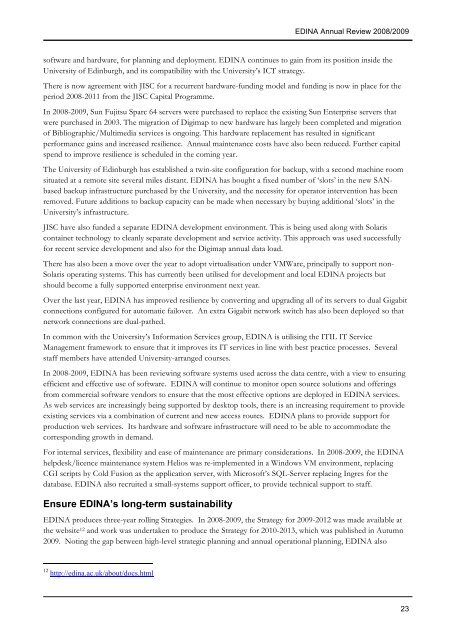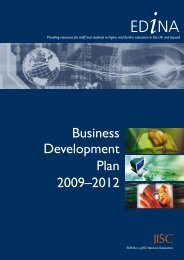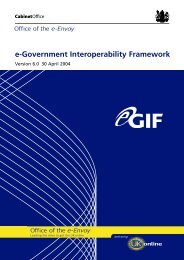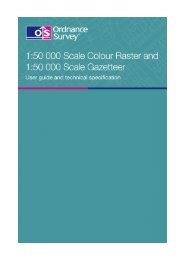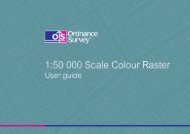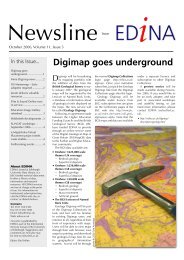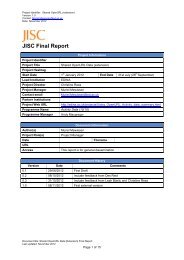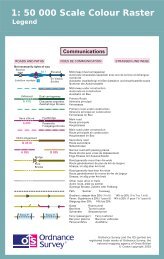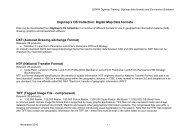Download PDF of the full Annual Review - Edina
Download PDF of the full Annual Review - Edina
Download PDF of the full Annual Review - Edina
Create successful ePaper yourself
Turn your PDF publications into a flip-book with our unique Google optimized e-Paper software.
EDINA <strong>Annual</strong> <strong>Review</strong> 2008/2009s<strong>of</strong>tware and hardware, for planning and deployment. EDINA continues to gain from its position inside <strong>the</strong>University <strong>of</strong> Edinburgh, and its compatibility with <strong>the</strong> University’s ICT strategy.There is now agreement with JISC for a recurrent hardware-funding model and funding is now in place for <strong>the</strong>period 2008-2011 from <strong>the</strong> JISC Capital Programme.In 2008-2009, Sun Fujitsu Sparc 64 servers were purchased to replace <strong>the</strong> existing Sun Enterprise servers thatwere purchased in 2003. The migration <strong>of</strong> Digimap to new hardware has largely been completed and migration<strong>of</strong> Bibliographic/Multimedia services is ongoing. This hardware replacement has resulted in significantperformance gains and increased resilience. <strong>Annual</strong> maintenance costs have also been reduced. Fur<strong>the</strong>r capitalspend to improve resilience is scheduled in <strong>the</strong> coming year.The University <strong>of</strong> Edinburgh has established a twin-site configuration for backup, with a second machine roomsituated at a remote site several miles distant. EDINA has bought a fixed number <strong>of</strong> ‘slots’ in <strong>the</strong> new SANbasedbackup infrastructure purchased by <strong>the</strong> University, and <strong>the</strong> necessity for operator intervention has beenremoved. Future additions to backup capacity can be made when necessary by buying additional ‘slots’ in <strong>the</strong>University’s infrastructure.JISC have also funded a separate EDINA development environment. This is being used along with Solariscontainer technology to cleanly separate development and service activity. This approach was used success<strong>full</strong>yfor recent service development and also for <strong>the</strong> Digimap annual data load.There has also been a move over <strong>the</strong> year to adopt virtualisation under VMWare, principally to support non-Solaris operating systems. This has currently been utilised for development and local EDINA projects butshould become a <strong>full</strong>y supported enterprise environment next year.Over <strong>the</strong> last year, EDINA has improved resilience by converting and upgrading all <strong>of</strong> its servers to dual Gigabitconnections configured for automatic failover. An extra Gigabit network switch has also been deployed so thatnetwork connections are dual-pa<strong>the</strong>d.In common with <strong>the</strong> University’s Information Services group, EDINA is utilising <strong>the</strong> ITIL IT ServiceManagement framework to ensure that it improves its IT services in line with best practice processes. Severalstaff members have attended University-arranged courses.In 2008-2009, EDINA has been reviewing s<strong>of</strong>tware systems used across <strong>the</strong> data centre, with a view to ensuringefficient and effective use <strong>of</strong> s<strong>of</strong>tware. EDINA will continue to monitor open source solutions and <strong>of</strong>feringsfrom commercial s<strong>of</strong>tware vendors to ensure that <strong>the</strong> most effective options are deployed in EDINA services.As web services are increasingly being supported by desktop tools, <strong>the</strong>re is an increasing requirement to provideexisting services via a combination <strong>of</strong> current and new access routes. EDINA plans to provide support forproduction web services. Its hardware and s<strong>of</strong>tware infrastructure will need to be able to accommodate <strong>the</strong>corresponding growth in demand.For internal services, flexibility and ease <strong>of</strong> maintenance are primary considerations. In 2008-2009, <strong>the</strong> EDINAhelpdesk/licence maintenance system Helios was re-implemented in a Windows VM environment, replacingCGI scripts by Cold Fusion as <strong>the</strong> application server, with Micros<strong>of</strong>t’s SQL-Server replacing Ingres for <strong>the</strong>database. EDINA also recruited a small-systems support <strong>of</strong>ficer, to provide technical support to staff.Ensure EDINA’s long-term sustainabilityEDINA produces three-year rolling Strategies. In 2008-2009, <strong>the</strong> Strategy for 2009-2012 was made available at<strong>the</strong> website 12 and work was undertaken to produce <strong>the</strong> Strategy for 2010-2013, which was published in Autumn2009. Noting <strong>the</strong> gap between high-level strategic planning and annual operational planning, EDINA also12 http://edina.ac.uk/about/docs.html23


